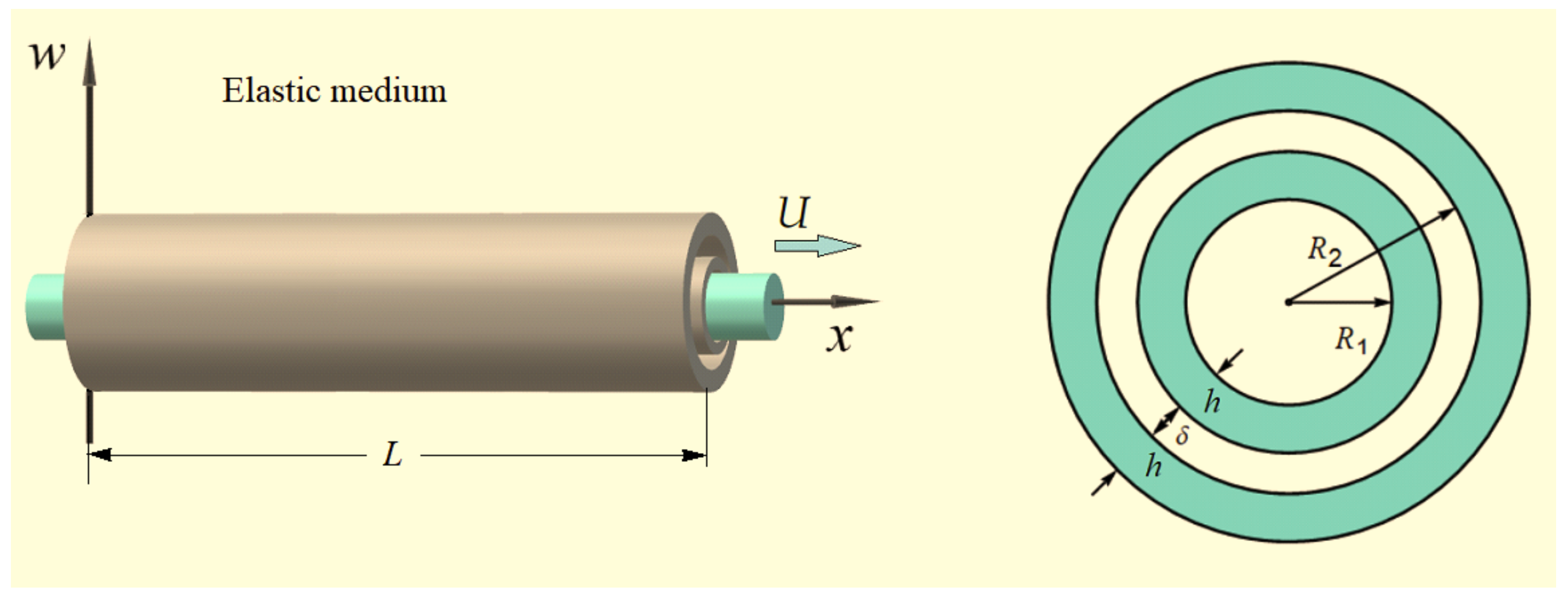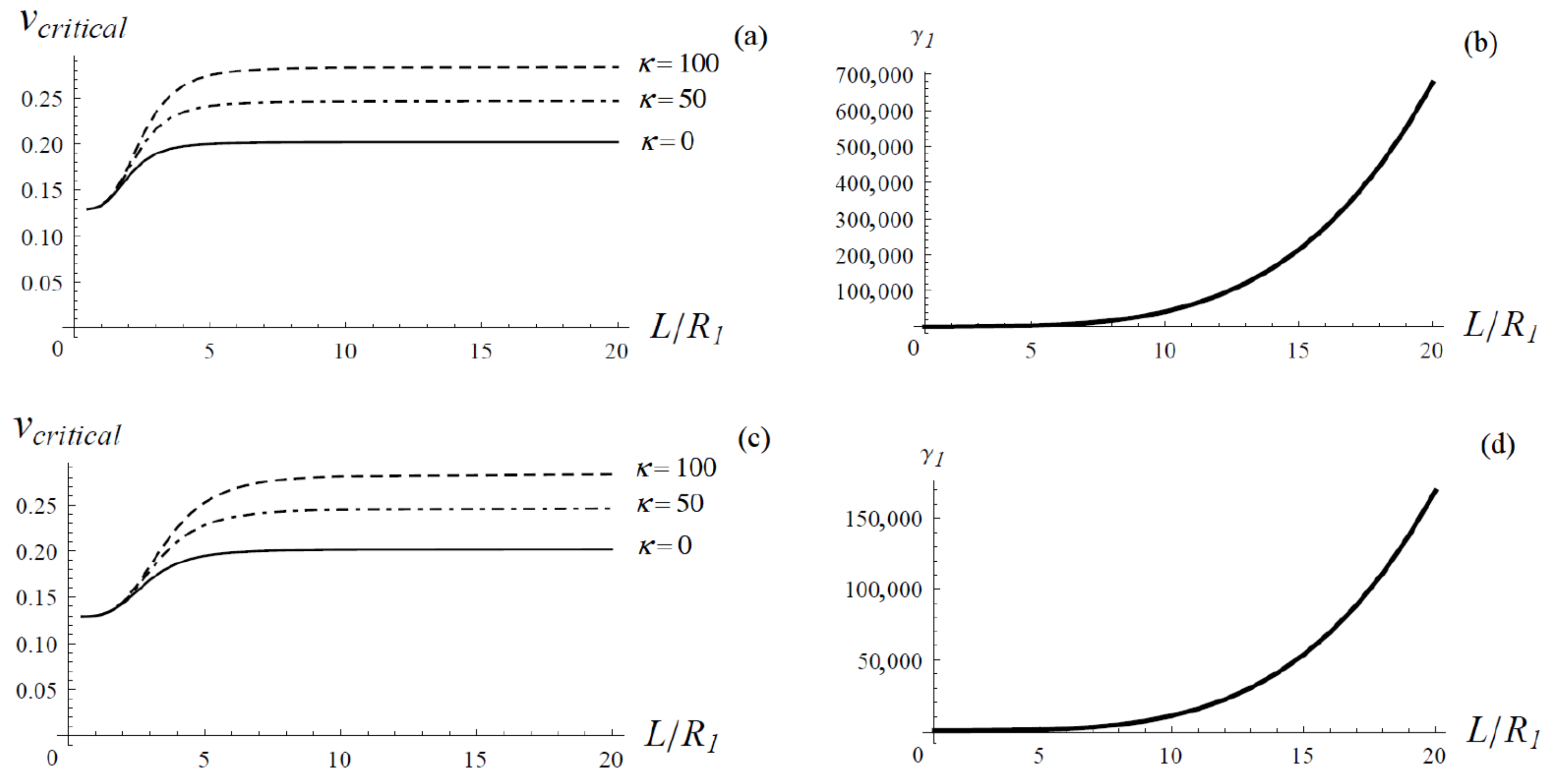Dynamics and Stability of Double-Walled Carbon Nanotube Cantilevers Conveying Fluid in an Elastic Medium
Abstract
1. Introduction
2. Equations of Motion and Boundary Conditions
3. Approximate Solutions
4. Numerical Implementation
5. Results and Discussion
5.1. Geometric and Intertube Interaction Characteristics
- Wall thickness of the tubes h: nm = m;
- Initial distance between the tubes : nm = m;
- Inside radius of the inner tube : nm = m;
- Inside radius of the outer tube : nm = m;
- Length of the tubes L: m ÷ m.
5.2. Material Characteristics
- Young’s modulus of the SWCNTs E: 1 TPa ÷ 4 TPa;
- Mass density of the SWCNTs : kg/m3;
- Mass density of the fluid M: kg/m3.
5.3. Critical Flow Velocity versus the Ratio of the Tube Length L to Its Inner Radius R1
6. Concluding Remarks
Author Contributions
Funding
Data Availability Statement
Conflicts of Interest
Abbreviations
| MEMS | Microelectromechanical systems |
| NEMS | Nanoelectromechanical systems |
| SWCNT | Single-walled carbon nanotube |
| DWCNT | Double-walled carbon nanotube |
| MWCNT | Multi-walled carbon nanotube |
References
- Pelesko, J.A.; Bernstein, D.H. Modeling MEMS and NEMS; Chapman & HallCRC: Boca Raton, FL, USA, 2003. [Google Scholar]
- DiVentra, M.; Evoy, S.; Heflin, J.R. (Eds.) Introduction to Nanoscale Science and Technology; Nanostructure Science and Technology; Springer: Boston, MA, USA, 2004. [Google Scholar] [CrossRef]
- Gibson, R.F.; Ayorinde, E.O.; Wen, Y.F. Vibrations of carbon nanotubes and their composites: A review. Compos. Sci. Technol. 2007, 67, 1–28. [Google Scholar] [CrossRef]
- Rafii-Tabar, H. Computational Physics of Carbon Nanotubes; Cambridge University Press: Cambridge, UK, 2008; p. 493. [Google Scholar]
- Magrab, E.B. Vibrations of Elastic Systems with Applications to MEMS and NEMS; Springer: Dordrecht, The Netherlands, 2012. [Google Scholar] [CrossRef]
- Elishakoff, I.; Pentaras, D.; Dujat, K.; Versaci, C.; Muscolino, G.; Storch, J.; Bucas, S.; Challamel, N.; Natsuki, T.; Zhang, Y.; et al. Carbon Nanotubes and Nanosensors; Wiley: Hoboken, NJ, USA, 2012. [Google Scholar] [CrossRef]
- Goddard, W.A.; Brenner, D.; Lyshevski, S.E.; Iafrate, G.J. (Eds.) Handbook of Nanoscience, Engineering, and Technology; CRC Press: Boca Raton, FL, USA, 2018. [Google Scholar] [CrossRef]
- Yakobson, B.I.; Brabec, C.J.; Bernholc, J. Nanomechanics of carbon tubes: Instabilities beyond linear response. Phys. Rev. Lett. 1996, 76, 2511–2514. [Google Scholar] [CrossRef] [PubMed]
- Tuzun, R.E.; Noid, D.W.; Sumpter, B.G.; Merkle, R.C. Dynamics of fluid flow inside carbon nanotubes. Nanotechnology 1996, 7, 241. [Google Scholar] [CrossRef]
- Holt, J.K. Carbon nanotubes and nanofluidic transport. Adv. Mater. 2009, 21, 3542–3550. [Google Scholar] [CrossRef]
- Sears, K.; Dumée, L.; Schütz, J.; She, M.; Huynh, C.; Hawkins, S.; Duke, M.; Gray, S. Recent developments in carbon nanotube membranes for water purification and gas separation. Materials 2010, 3, 127. [Google Scholar] [CrossRef]
- Majumder, M.; Chopra, N.; Andrews, R.; Hinds, B.J. Enhanced flow in carbon nanotubes. Nature 2005, 438, 44. [Google Scholar] [CrossRef] [PubMed]
- Holt, J.K.; Park, H.G.; Wang, Y.; Stadermann, M.; Artyukhin, A.B.; Grigoropoulos, C.P.; Noy, A.; Bakajin, O. Fast mass transport through sub-2-nanometer carbon nanotubes. Science 2006, 312, 1034–1037. [Google Scholar] [CrossRef]
- Whitby, M.; Quirke, N. Fluid flow in carbon nanotubes and nanopipes. Nat. Nanotechnol. 2007, 2, 87–94. [Google Scholar] [CrossRef] [PubMed]
- Yoon, J.; Ru, C.; Mioduchowski, A. Vibration and instability of carbon nanotubes conveying fluid. Compos. Sci. Technol. 2005, 65, 1326–1336. [Google Scholar] [CrossRef]
- Yoon, J.; Ru, C.Q.; Mioduchowski, A. Flow-induced flutter instability of cantilever carbon nanotubes. Int. J. Solids Struct. 2006, 43, 3337–3349. [Google Scholar] [CrossRef]
- Reddy, C.D.; Lu, C.; Rajendran, S.; Liew, K.M. Free vibration analysis of fluid-conveying single-walled carbon nanotubes. Appl. Phys. Lett. 2007, 90, 133122. [Google Scholar] [CrossRef]
- Reddy, C.D.; Lu, C. Does natural frequency quantify the mass flow rate of single-walled carbon nanotubes? J. Appl. Phys. 2008, 103, 123509. [Google Scholar] [CrossRef]
- Wang, L.; Ni, Q.; Li, M. Buckling instability of double-wall carbon nanotubes conveying fluid. Comput. Mater. Sci. 2008, 44, 821–825. [Google Scholar] [CrossRef]
- He, X.Q.; Wang, C.M.; Yan, Y.; Zhang, L.X.; Nie, G.H. Pressure dependence of the instability of multiwalled carbon nanotubes conveying fluids. Arch. Appl. Mech. 2008, 78, 637–648. [Google Scholar] [CrossRef]
- Wang, L. Dynamical behaviors of double-walled carbon nanotubes conveying fluid accounting for the role of small length scale. Comput. Mater. Sci. 2009, 45, 584–588. [Google Scholar] [CrossRef]
- Tounsi, A.; Heireche, H.; Benzair, A.; Mechab, I. Comment on “Vibration analysis of fluid-conveying double-walled carbon nanotubes based on nonlocal elastic theory”. J. Phys. Condens. Matter 2009, 21, 448001. [Google Scholar] [CrossRef] [PubMed]
- Lee, H.L.; Chang, W.J. Vibration analysis of fluid-conveying double-walled carbon nanotubes based on nonlocal elastic theory. J. Phys. Condens. Matter 2009, 21, 115302. [Google Scholar] [CrossRef] [PubMed]
- Yan, Y.; Wang, W.; Zhang, L. Dynamical behaviors of fluid-conveyed multi-walled carbon nanotubes. Appl. Math. Model. 2009, 33, 1430–1440. [Google Scholar] [CrossRef]
- Yan, Y.; He, X.Q.; Zhang, L.X.; Wang, C.M. Dynamic behavior of triple-walled carbon nanotubes conveying fluid. J. Sound Vib. 2009, 319, 1003–1018. [Google Scholar] [CrossRef]
- Kuang, Y.; He, X.; Chen, C.; Li, G. Analysis of nonlinear vibrations of double-walled carbon nanotubes conveying fluid. Comput. Mater. Sci. 2009, 45, 875–880. [Google Scholar] [CrossRef]
- Natsuki, T.; Lei, X.W.; Ni, Q.Q.; Endo, M. Free vibration characteristics of double-walled carbon nanotubes embedded in an elastic medium. Phys. Lett. A 2010, 374, 2670–2674. [Google Scholar] [CrossRef]
- Askari, H.; Younesian, D.; Esmailzadeh, E.; Cveticanin, L. Nonlocal effect in carbon nanotube resonators: A comprehensive review. Adv. Mech. Eng. 2017, 9, 1–24. [Google Scholar] [CrossRef]
- Bourrières, F.J. Sur un Phénomène d’Oscillation Auto-Entretenue en Mécanique des Fluids Réels; Publications Scientifiques et Techniques du Ministère de l’Air; E. Blondel La Rougery: Paris, France, 1939; Volume 147. [Google Scholar]
- Niordson, F. Vibrations of a Cylindrical Tube Containing Flowing Fluid; Kungliga Tekniska Högskolans Handlingar; Lindstahl: Stockholm, Sverige, 1953; Volume 73. [Google Scholar]
- Benjamin, T.B. Dynamics of a system of articulated pipes conveying fluid. I. Theory. Proc. R. Soc. Lond. A 1961, 261, 457–486. [Google Scholar] [CrossRef]
- Gregory, R.W.; Païdoussis, M.P. Unstable oscillation of tubular cantilevers conveying fluid. I. Theory. Proc. R. Soc. Lond. A 1966, 293, 512–527. [Google Scholar] [CrossRef]
- Paidoussis, M.P. Fluid-Structure Interactions. Slender Structures and Axial Flow, 2nd ed.; Academic Press: London, UK, 2014; Volume 1. [Google Scholar]
- Paidoussis, M.P. Fluid-Structure Interactions. Slender Structures and Axial Flow, 2nd ed.; Academic Press: London, UK, 2016; Volume 2. [Google Scholar]
- Ru, C.Q. Column buckling of multiwalled carbon nanotubes with interlayer radial displacements. Phys. Rev. B 2000, 62, 16962–16967. [Google Scholar] [CrossRef]
- Yoon, J.; Ru, C.Q.; Mioduchowski, A. Noncoaxial resonance of an isolated multiwall carbon nanotube. Phys. Rev. B 2002, 66, 233402. [Google Scholar] [CrossRef]
- Lolov, D.; Lilkova-Markova, S. Dynamic stability of double-walled carbon nanotubes. J. Serbian Soc. Comput. Mech. 2018, 12, 1–8. [Google Scholar] [CrossRef]
- Zuo, Q.H.; Schreyer, H.L. Flutter and divergence instability of nonconservative beams and plates. Int. J. Solids Struct. 1996, 33, 1355–1367. [Google Scholar] [CrossRef]
- Elaikh, T.E.H.; Abed, N.M.; Ebrahimi-Mamaghani, A. Free vibration and flutter stability of interconnected double graded micro pipes system conveying fluid. IOP Conf. Ser. Mater. Sci. Eng. 2020, 928, 022128. [Google Scholar] [CrossRef]
- Lolov, D.; Lilkova-Markova, S. The model of interconnected pipes in the investigation of dynamic stability of carbon nanotubes embedded in an elastic medium. Stroj. Časopis J. Mech. Eng. 2023, 73, 93–98. [Google Scholar] [CrossRef]
- Beer, F.P. Vector Mechanics for Engineers: Statics and Dynamics, 11th ed.; McGraw-Hill: New York, NY, USA, 2013; p. 1392. [Google Scholar]
- Fletcher, C.A.J. Computational Galerkin Methods; Springer Series in Computational Physics; Springer: Berlin, Germany, 1984. [Google Scholar]
- Courant, R.; Hilbert, D. Methods of Mathematical Physics; John Wiley & Sons: New York, NY, USA, 1989; Volume I. [Google Scholar]
- Wolfram, S. The Mathematica Book, 5th ed.; Wolfram Media: Champaign, IL, USA, 2003. [Google Scholar]
- Strozzi, M. Applicability and limitations of Ru’s formulation for vibration modelling of double-walled carbon nanotubes. C—J. Carbon Res. 2022, 8, 59. [Google Scholar] [CrossRef]
- Yoon, J.; Ru, C.Q.; Mioduchowski, A. Timoshenko-beam effects on transverse wave propagation in carbon nanotubes. Compos. Part B Eng. 2004, 35, 87–93. [Google Scholar] [CrossRef]
- Wang, C.M.; Tan, V.B.C.; Zhang, Y.Y. Timoshenko beam model for vibration analysis of multi-walled carbon nanotubes. J. Sound Vib. 2006, 294, 1060–1072. [Google Scholar] [CrossRef]
- Liu, R.; Wang, L. Vibration of cantilevered double-walled carbon nanotubes predicted by Timoshenko beam model and molecular dynamics. Int. J. Comput. Methods 2015, 12, 1540017. [Google Scholar] [CrossRef]
- Liu, R.; Zhao, J.; Wang, L. Flexural wave propagation in mass chain-filled carbon nanotubes. Materials 2019, 12, 2986. [Google Scholar] [CrossRef]



Disclaimer/Publisher’s Note: The statements, opinions and data contained in all publications are solely those of the individual author(s) and contributor(s) and not of MDPI and/or the editor(s). MDPI and/or the editor(s) disclaim responsibility for any injury to people or property resulting from any ideas, methods, instructions or products referred to in the content. |
© 2024 by the authors. Licensee MDPI, Basel, Switzerland. This article is an open access article distributed under the terms and conditions of the Creative Commons Attribution (CC BY) license (https://creativecommons.org/licenses/by/4.0/).
Share and Cite
Vassilev, V.M.; Valchev, G.S. Dynamics and Stability of Double-Walled Carbon Nanotube Cantilevers Conveying Fluid in an Elastic Medium. Dynamics 2024, 4, 222-232. https://doi.org/10.3390/dynamics4020013
Vassilev VM, Valchev GS. Dynamics and Stability of Double-Walled Carbon Nanotube Cantilevers Conveying Fluid in an Elastic Medium. Dynamics. 2024; 4(2):222-232. https://doi.org/10.3390/dynamics4020013
Chicago/Turabian StyleVassilev, Vassil M., and Galin S. Valchev. 2024. "Dynamics and Stability of Double-Walled Carbon Nanotube Cantilevers Conveying Fluid in an Elastic Medium" Dynamics 4, no. 2: 222-232. https://doi.org/10.3390/dynamics4020013
APA StyleVassilev, V. M., & Valchev, G. S. (2024). Dynamics and Stability of Double-Walled Carbon Nanotube Cantilevers Conveying Fluid in an Elastic Medium. Dynamics, 4(2), 222-232. https://doi.org/10.3390/dynamics4020013






